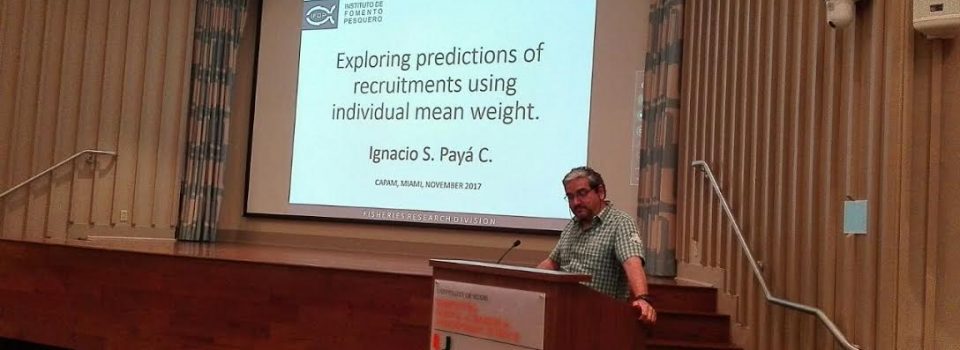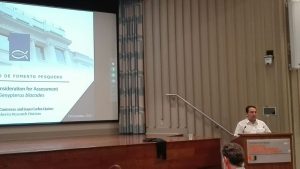IFOP scientists show fish recruitment advanced research at international workshop
November 24th, 2017Between October 29th and November 4th , International workshop Recruitment: Theory, Estimation, and Application in Fishery Stock Assessment Models, organized by the Center for the Advancement of Population Assessment Methodology (CAPAM) was held at the University of Miami, USA. Researchers Ignacio Payá and Francisco Contreras attended representing IFOP.
This workshop objective was to provide advice and guidance on modeling recruitment in fishery assessments practices. The focus was on the model specification, parameters estimation and management consequences. The 5-day forum included an interactive modeling session, keynote lectures and research presentations, and discussions focused on main themes which describe mechanistic process modeling implications and time series management. The main topics included: Underlying biological processes, population-recruitment relationship, recruitment temporal variation, spatial and other considerations, contracting models administrative implications, recruitment evaluation in tuna stock assessments – CSIRO.
Francisco Contreras presented “Space research in Golden kingklip stock modeling “. the scientist detailed “there is a high correlation history between northern and southern areas of the Southern Demersal Fisheries recruitments, which leads to resource modeling assuming autocorrelation of recruitment patterns. In this sense, hypotheses about productivity stock proportionality in both administrative areas of Chile are contrasted, considering for this scenarios of uniform and stochastic self-correlation between zones and years. In terms of data, Golden kingklip is managed in two separated zones in Chile, where each zone has abundance indexes (CPUE), catch matrices to age, landings, life history parameters (maturity, growth and mortality). natural). At present, stock assessment considers stock analysis separately, without interaction, however, the present study analyzes through a spatial model combined information, evaluating implications in fisheries management. Concluding that it is feasible to model the stocks with random proportionality between zones, obtaining similar levels of tendency to the independent stock assessment model. Additionally, it is considered a contribution in the evaluation of the resource, which nevertheless must be complemented with future work that evaluated other forms of proportionality between zones, and thus consider the impact of regime changes or systematic failures in the resource’s recruitments “.
Ignacio Payá presented “Exploring prediction of recruitment using individual average weight“, which he summarized as “Hake, common hake and horse mackerel inhabit Humboldt currents system, where there are major environmental changes related to El Niño events and decadal oscillations. Their recruitments have large fluctuations, autocorrelations and some strong annual classes. Recruitment models cannot reproduce these fluctuations unless process errors are included in stock-recruit models. These process errors have been related to environmental variables, but models have not been able to reproduce strong annual classes. These populations are overexploited, their age structures truncated and the average individuals weight has changed over the years. Age truncation has effects on biomass spawning and, therefore, on recruitments that are predicted by the classic model of population recruitment. To date, the impact on age truncation in spawning stock has been investigated, but not in total stock. This work in progress attempts to understand the impact of change in average weight individual on the total stock in recruitment predictions of mentioned populations. State variables used were the results of age-structured stock assessment models with process errors in the recruitment models, which were carried out in ADMB. Different generalized additive models (GAM) were analyzed and compared using AIC. The best models included the number of individuals and the individual average weight of the previous year. Contrary to expectations, the El Niño index did not improve the GAM. The three species form schools and have been fished with trap nets, so positive contributions to small average weights recruitment could be related to a greater fish of similar sizes abundance that obtain more protection. “

